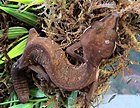Eublepharidae
| Eublepharidae | |
|---|---|

| |
| Common leopard gecko (Eublepharis macularius) | |
| Scientific classification | |
| Domain: | Eukaryota |
| Kingdom: | Animalia |
| Phylum: | Chordata |
| Class: | Reptilia |
| Order: | Squamata |
| Infraorder: | Gekkota |
| Superfamily: | Gekkonoidea |
| Family: | Eublepharidae Boulenger, 1883 |
| Genera | |
|
See text | |
The Eublepharidae are a family of geckos (Gekkota) consisting of 43 described species in 6 genera. They occur in Asia, Africa, North America, and Central America. [1][2][3][4] Eublepharid geckos lack adhesive toepads and, unlike other geckos, have movable eyelids, thus commonly called eyelid geckos. Like other members of Gekkota, the Eublepharidae exhibits tail autotomy due to the fracture planes near their vent. A new tail will then grow in its place, usually lacking the original color and texture. The muscles in the old tail will continue to flex for up to 30 minutes after the drop to distract predators.[5] Leopard geckos (Eublepharis macularius) and African fat-tailed geckos (Hemitheconyx caudicinctus) are popular pet lizards.
Genera
[edit]The following genera are considered members of the Eublepharidae:
| Genus | Image | Type species | Taxon author | Common name | Species |
|---|---|---|---|---|---|
| Aeluroscalabotes |  A. felinus |
A. felinus (Günther, 1864) | Boulenger, 1885 | Cat gecko | 1 |
| Coleonyx |  C. variegatus |
C. elegans Gray, 1845 | Gray, 1845 | Banded geckos | 9 |
| Eublepharis |  E. macularius |
E. hardwickii Gray, 1827 | Gray, 1827 | Leopard geckos | 7 |
| Goniurosaurus |  G. kuroiwae |
G. hainanensis Barbour, 1908 | Barbour, 1908 | Ground and cave geckos | 26 |
| Hemitheconyx |  H. caudicinctus |
H. caudicinctus (Duméril, 1851) | Stejneger, 1893 | Fat-tailed geckos | 2 |
| Holodactylus |  H. africanus |
H. africanus Boettger, 1893 | Boettger, 1893 | Clawed geckos | 2 |
References
[edit]- ^ Grismer, L.L. 1988. Phylogeny, taxonomy, classification, and biogeography of eublepharid geckos. In: Phylogenetic Relationships of the Lizard Families (R. Estes & G. Pregill, eds), pp. 369–469. Stanford University Press, Stanford, CA.
- ^ Gamble, Tony; Greenbaum, Eli; Jackman, Todd R.; Russell, Anthony P.; Bauer, Aaron M. (June 27, 2012). "Repeated Origin and Loss of Adhesive Toepads in Geckos". PLOS ONE. 7 (6): e39429. Bibcode:2012PLoSO...739429G. doi:10.1371/journal.pone.0039429. PMC 3384654. PMID 22761794.
- ^ Gamble, T.; Bauer, A.M.; Colli, G.R.; Greenbaum, E.; Jackman, T.R.; Vitt, L.J.; Simons, A.M. (February 2011). "Coming to America: Multiple Origins of New World Geckos". Journal of Evolutionary Biology. 24 (2): 231–244. doi:10.1111/j.1420-9101.2010.02184.x. PMC 3075428. PMID 21126276.
- ^ Gamble, T.; Greenbaum, E.; Jackman, T.R.; Bauer, A.M. (August 2015). "Into the light: Diurnality has evolved multiple times in geckos". Biological Journal of the Linnean Society. 115 (4): 896–910. doi:10.1111/bij.12536.
- ^ Cohn, Jeffrey P. (2009). "Tail loss in lizards". BioScience. 59 (8): 728. doi:10.1525/bio.2009.59.8.23. S2CID 84194254.
